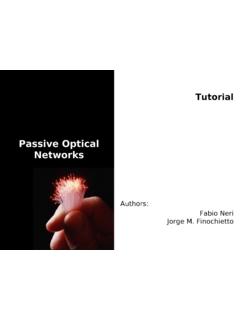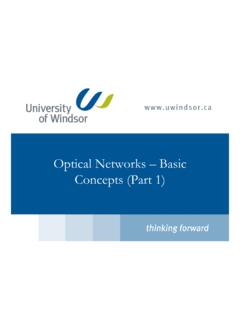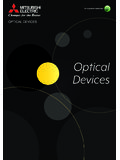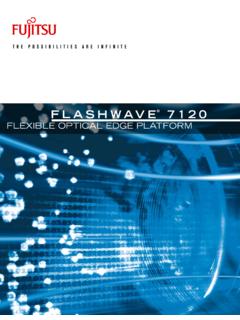Transcription of SCTE’S NYC CHAPTER PRESENTS
1 SCTE'S. NYC CHAPTER . PRESENTS . EPON AND RFoG. TECHNOLOGY OVERVIEW. AGENDA AND. HOUSEKEEPING ITEMS. EPON Technology Overview Introduction to DPoE. DPoE and Next Generation EPON. RFoG and HPON Why? What How? p2. HOW TO ASK A QUESTION. At the end of each presentation, there will be a chance for questions. If you are attending by webinar, please put your questions in the Adobe chat box. p3. SCTE'S. NYC CHAPTER . PRESENTS . EPON AND DPOE. TODAY'S SPEAKER. Hector Mayorga Sumitomo Electric Lightwave Agenda EPON Technology Overview Introduction to DPoE. DPoE and Next Generation EPON. EPON Technology Overview First, a bit of history on access networks . Access networks are part of a telecommunications network that connect users to their providers Historically they were made out of twisted copper wires for telephone access. These providers are known as telcos . Another type of access technology is Cable TV service which is delivered through a coaxial cable, TV was the only service offered in the early days.
2 First, a bit of history on access networks . Over time the access network became capable of delivering other services, like high speed data, video, and voice. This created the need for more bandwidth. Technologies like xVDSL for telcos or DOCSIS and in the cable world have increased bandwidth over the years, keeping the existing networks alive. Regardless, these technologies are not enough to deliver multigigabit/s service to residential and commercial subscribers today Fiber to the rescue! Unlike twisted copper pairs or coax cable, optical fiber is capable of delivering today symmetric 10 Gbps of data, voice, and video services at distances equal or beyond 20 kilometers from a central location to a subscriber. This is known as Fiber to the x (FTTx) service, where x = Home, Business, Premises, etc . Fiber can be deployed in the local access network using a point-to-point (PtP) or point-to-multipoint (PtMP) topology, with dedicated fiber runs from the HUB to each end-user (subscriber).
3 One cost effective way of delivering FTTH service is with the use of Passive Optical Networks OK, so what exactly is a PON? Definition of PON Passive Optical network . Is a point-to-multipoint, Fiber-to-the-Premises (FTTP) network architecture. Is called passive because unpowered optical splitters are used to enable a single optical fiber to serve multiple premises, typically 16-128. It consists of Optical Line Terminals (OLT), and more than one Optical network Units (ONUs) and connected through the Optical Distribution network (ODN). The ODN is an optical access network without any active electronic devices between OLT and ONU. Components in a PON network Headend ODN Subscriber ONU. Splitter ONU. OLT. PON Technologies Different standard groups created different PON. standards: ITU-T G IEEE SCTE. Point-to-Multipoint FTTx Technologies BPON EPON. 622 Mbps 1 Gbps RFoG. GPON 10G EPON. 10 Gbps XG-PON1 NG-EPON.
4 10x1 Gbps 40/100 Gbps? NG-PON2. 40x10 Gbps? EPON a Mature Technology Option EPON was initially chosen by MSOs as the preferred PON. architecture based on several high level factors: Simple Protocol based on Ethernet Framing instead of more expensive and complicated GPON specification (ATM) which affects future pricing Momentum already made toward a DOCSIS based provisioning model 10G specification was completed in 2009, with product available today! EPON a Mature Technology Option (2). In collaboration with CableLabs, MSO's have spent 5+ years working with contributing vendors to develop specifications for DOCSIS Provisioning of EPON (DPoE). DPoE focuses on the following concepts: Multi-vendor interoperability Metro Ethernet services functionality for commercial services Multigigabit IP/HSD residential service Capable of provisioning millions of devices Use of existing MSO back office systems Simplified provisioning and access network speeds of 10 Gbps are key differentiators for MSOs against existing and new service providers.
5 Minimizes fiber deployment and number of transceivers in the field compared to CWDM (lower CAPEX). No active devices in the field (lower OPEX). EPON as Universal Fiber Access Architecture All Service Types Residential MTU Cellular ONU. Businesses Backhaul Cat-5 / xDSL / EoC. per Floor Riser Cellular backhaul Business OLT with All Configurations Traffic Management Clock ONU. FTTB. Transport MDU/MTU FTTB- IEEE 1588. MTU ONU in FTTH 1Gb/s MTU Wiring Closet /. Basement Gb/s . FTTC/FTTN 10 Gb/s . 1 Gb/s All Data Rates 10 Gb/s 1Gb/s FTTC / FTTN. ( 2004) ONU in Outside 10/1 and 10/10 Cabinet xDSL. ( 2009) FTTH SL. xD. Home Networking All supported on the same SFU. ONU. outside plant (ODN)! GE. HGW x oa /C. FE. STB / IP-STB. EPON Technology Roadmap EPON standard evolution: : 1G/1G specification (2004). : 10G/10G specification (2009). DPoEv1: DOCSIS Provisioning over EPON (2011). DPoEv2: (2012). SIEPON: Service Interoperability in Ethernet Passive Networks (2013).
6 NG-EPON: IEEE already working on next generation EPON for speeds of 40 or 100 Gbps. 2004 2009 2011 2012 2014 Work in Progress SIEPON NG-EPON. DPoE DPoE EPON Components A typical EPON system is composed of an OLT, several ONUs and an ODN. The OLT (Optical Line Terminal) resides in the MSO's hubs, or sometimes in a MDU, it connects the optical access network to the core. OLTs can be a switch or router and contain EPON. interfaces. It's the optical equivalent of a CMTS. The ONU (Optical network Unit) is located at the end-user location (customer premises), it has an optical transceiver and provides services such as voice, data and video. It's the optical equivalent of a Cable Modem. The ODN (Optical Distribution network ) connects the OLT and ONU. In the ODN one fiber carries the DS and US signals using WDM. Fibers are then split to serve individual ONUs. The optical splitter is a simple passive device.
7 EPON US/DS Wavelengths An EPON system uses Wavelength Division Multiplexing (WDM) in order to achieve two way communication on a single fiber. DS: 1490 10 nm (1 Gbps) ONU. 1577 -2/+3nm (10 Gbps). OLT. US: 1310 50 nm (1 Gbps). 1270 10 nm (10 Gbps). ONU. 1. 1270 RFoG RFoG. 5. 10nm DS US. 7. 1490 7. 10nm n 1310 50nm m 15. 1575. 12. 13. 13. 14. 15. 15. 16. 80. 60. 10. 60. 80. 00. 50. 10. Two multiplexing technologies are used: Broadcast on the downstream flows (TDM). TDMA on upstream flows EPON Architectures Models Tree topology (a) is typically used in China, US and Europe for residential and business customers with no physical layer resiliency requirements Bus topology (b) is typically used in Japan (where most fiber is deployed in aerial bus-type architecture). Ring topology (c) used typically for networks with high resilience (tree / trunk protection under SIEPON). The EPON protocol works on any ODN (optical distribution network ) architecture Optical Power Levels (1 Gig EPON) (10 Gig EPON).
8 1000 BASE-PX20 Transceivers 10 GBASE PR D3 Transceivers OLT: OLT: TX Wavelength: 1480 to 1500nm TX Wavelength: 1575 to 1580nm TX: +2 to +7dBm TX: +2 to +5dBm RX: -6 to -27dBm RX: -6 to -28dBm ONU: TX Wavelength: 1260 to 1360nm ONU: TX: -1 to +4dBm TX Wavelength: 1260 to 1280nm RX:-3 to -24dBm TX: +4 to +9dBm RX:-10 to Downstream Traffic OLT broadcasts data to every ONU. ONUs receive a Logical Link ID (LLID) upon registration (can be more than one LLID). This is similar to a cable modem receiving a pair of service flows (US/DS). in DOCSIS. ONU only forwards traffic to its own set of active LLIDs. To broadcast data to all ONUs the OLT uses TDM (Time Division Multiplexing). ONU 1. 1. Client 1. OLT ONU 2. 3 1 3 2 3 1 3 2 2. Client 2. Passive Optical ONU 3. Splitter 1: N. (Distribution point) 3 3. Client 3. Upstream Traffic During ONU registration the OLT calculates the time delay (distance) from ONU. and instructs it to adjust its transmission parameters.
9 Each ONU only transmits during the assigned timeslots from OLT. Transmission from each ONU arrives at the OLT without collisions To provide multiple access to a single fiber link for all connected ONUs, Time Division Multiple Access (TDMA) architecture is implemented for the Upstream channel ONU 1. 1 1. Client 1. OLT ONU 2. 3 1 1 2 2 2. Client 2. Passive Optical ONU 3. Splitter 1: N. (Distribution point) 3. Client 3. DPoE. DOCSIS Provisioning of EPON. What is DPoE. DOCSIS Provisioning of EPON (DPoE ) is a joint effort of operators, vendors, and suppliers to support EPON technology using existing DOCSIS-based back office systems and processes. Goal is to share the same Provisioning Platform for DOCSIS and EPON: DOCSIS DPoE (DML). OLT. Today's back office implementation can be reused Reason's for Developing DPoE Specs Neither 1G-EPON nor 10G-EPON as specified in IEEE define any OAMP. that allows forwarding of traffic between an ONU User Interface (UNI) and the PON.
10 Before DPoE all provisioning of EPON services was a manual process, thus making it difficult to sustain for large deployments. Some automated tools have been developed but they are all proprietary and don't integrate well with the MSO's existing infrastructure. One of the primary goals of the DPoE specifications is to provide an interoperable method of reaching the controller for the ONU, identifying the ONU capabilities, and providing that information to the OLT so that it can configure service on an ONU. The other is to adopt DOCSIS-based back office provisioning and operations models to EPON. This is the core objective of the DPoE specifications. The DOCSIS Mediation Layer The DOCSIS Mediation Layer (DML) is a process that resides on the DPoE. system that translates all DOCSIS specific provisioning into EPON, as defined by the CableLabs DPoE specifications. Some of its tasks are: Interprets the DOCSIS MIBs Creates virtual Cable Modems (vCMs) for management purposes since ONUs do not have an IP stack Requests IP addresses and configuration files for vCMs Translates the parameters received in the DOCSIS configuration file for each vCM to EPON OAM messages for the ONU.







